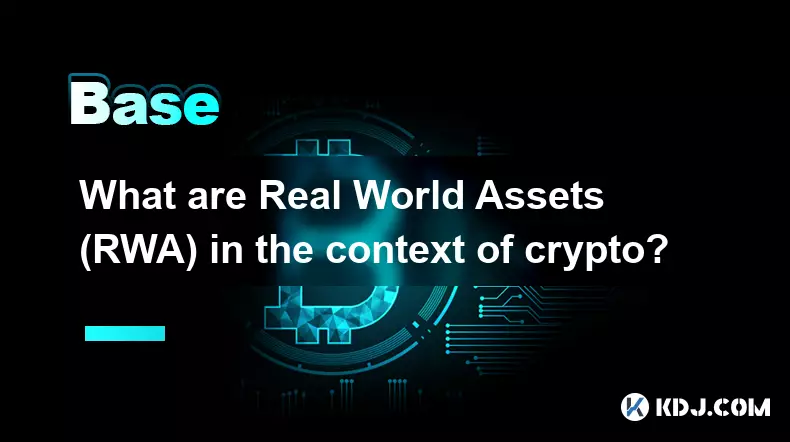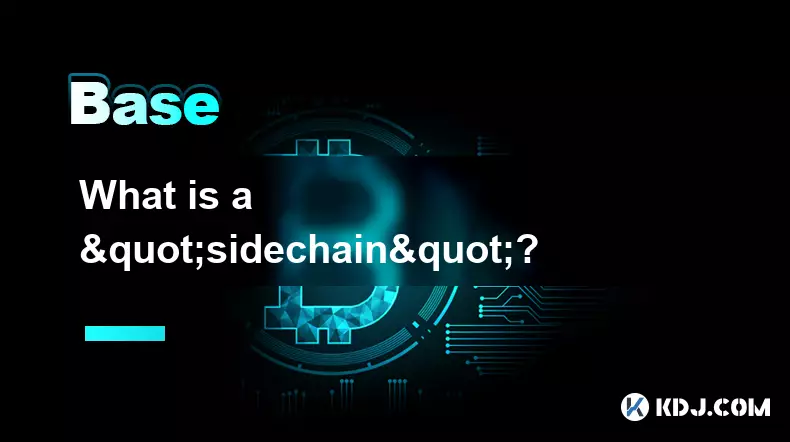-
 bitcoin
bitcoin $115692.075601 USD
5.13% -
 ethereum
ethereum $4162.931611 USD
11.68% -
 bnb
bnb $1310.063287 USD
17.56% -
 tether
tether $1.000983 USD
0.00% -
 xrp
xrp $2.534505 USD
8.16% -
 solana
solana $198.235737 USD
13.49% -
 usd-coin
usd-coin $1.000236 USD
0.02% -
 dogecoin
dogecoin $0.207352 USD
12.89% -
 tron
tron $0.323043 USD
3.62% -
 cardano
cardano $0.701559 USD
11.88% -
 hyperliquid
hyperliquid $39.924597 USD
8.30% -
 chainlink
chainlink $18.934457 USD
11.56% -
 ethena-usde
ethena-usde $1.000552 USD
0.02% -
 stellar
stellar $0.340575 USD
7.05% -
 bitcoin-cash
bitcoin-cash $545.011757 USD
8.86%
What are Real World Assets (RWA) in the context of crypto?
Real World Assets (RWA) in crypto bridge traditional finance with blockchain, enabling tokenized ownership of real estate, bonds, and more for greater liquidity, transparency, and DeFi integration.
Oct 13, 2025 at 07:36 am

Understanding Real World Assets in the Crypto Ecosystem
1. Real World Assets (RWA) refer to tangible or intangible assets that exist outside the blockchain but are represented as digital tokens on a distributed ledger. These can include real estate, commodities, bonds, equities, intellectual property, and even fine art. By tokenizing such assets, ownership and transfer become more efficient, transparent, and accessible to a broader range of participants.
2. The core idea behind RWA in crypto is to bridge traditional financial systems with decentralized networks. Instead of relying solely on centralized institutions to manage asset records, blockchain technology enables immutable, verifiable, and programmable representations of value. This integration reduces friction in settlement, enhances liquidity, and allows fractional ownership, which was previously difficult or cost-prohibitive in legacy markets.
3. Tokenization involves creating a digital twin of an asset on a blockchain, backed 1:1 by the underlying physical or legal entity. For example, a commercial building worth $10 million could be divided into one million tokens, each representing $10 of equity. These tokens can then be traded on decentralized exchanges, enabling investors to buy, sell, or collateralize portions of high-value assets without intermediaries.
4. Regulatory compliance plays a critical role in RWA adoption. Since these assets are tied to real-world legal frameworks, issuers must ensure adherence to jurisdictional laws regarding securities, anti-money laundering (AML), and know-your-customer (KYC) requirements. Smart contracts can embed compliance rules directly into the token logic, automating restrictions based on investor accreditation or geographic location.
5. Custodianship and auditability remain key challenges. Unlike purely digital cryptocurrencies, RWAs require trusted third parties—such as licensed custodians or legal entities—to hold and verify the physical asset backing the token. Regular audits and proof-of-reserves mechanisms help maintain trust and prevent fraud, ensuring that the digital representation remains fully backed at all times.
The Role of Decentralized Finance in RWA Integration
1. DeFi protocols have begun incorporating RWA-backed tokens into their lending and borrowing markets. Platforms like Aave and MakerDAO now accept tokenized U.S. Treasury bills and corporate bonds as collateral, expanding the range of acceptable assets beyond volatile cryptocurrencies. This shift introduces stability and yield-generating potential into otherwise speculative ecosystems.
2. Yield-bearing RWAs provide predictable returns denominated in fiat currencies, making them attractive for risk-averse investors seeking exposure to blockchain-based finance. For instance, a tokenized bond paying 5% annual interest can be integrated into a liquidity pool, allowing users to earn consistent rewards without selling their position.
3. Cross-chain interoperability enhances accessibility. RWA tokens minted on one blockchain—such as Ethereum—can be bridged to other networks like Polygon or Avalanche, where transaction costs are lower and throughput is higher. This flexibility supports global participation and enables seamless integration across multiple financial applications.
4. Liquidity fragmentation is a growing concern. As different platforms issue similar RWA tokens under varying standards, price discrepancies and inefficiencies emerge. Solutions involving standardized token frameworks and oracles that report real-time valuations aim to unify pricing and improve market depth.
5. Institutional demand drives innovation. Banks, hedge funds, and pension funds are increasingly exploring tokenized RWAs as a way to modernize infrastructure. Projects like BlackRock’s BUIDL initiative demonstrate how major financial players are leveraging public blockchains to offer regulated, on-chain investment products.
Challenges and Risks Associated with RWA Tokenization
1. Legal enforceability of smart contract terms remains uncertain in many jurisdictions. If a dispute arises over ownership or payment obligations, courts may not recognize code-based agreements as binding, creating ambiguity around recourse and liability.
2. Counterparty risk does not disappear—it shifts. While blockchain eliminates certain intermediaries, reliance on custodians, auditors, and legal trustees introduces new points of failure. If a custodian mismanages assets or becomes insolvent, token holders may lose their claims despite having valid on-chain records.
3. Market manipulation is possible due to low trading volumes on some RWA platforms. Illiquid markets make it easier for bad actors to influence prices through wash trading or spoofing, undermining confidence in fair valuation.
4. Oracle dependency creates vulnerabilities. Accurate pricing and performance data for RWAs depend on external feeds. If these sources are compromised or delayed, automated systems like lending platforms might liquidate positions incorrectly or fail to adjust collateral ratios appropriately.
5. Scalability limitations affect adoption speed. Public blockchains often struggle with high fees and slow confirmation times during peak usage, deterring large-scale deployment of RWA solutions that require frequent, reliable transactions.Common Questions About Real World Assets in Crypto
What types of assets are commonly tokenized as RWA?Real estate, government and corporate bonds, precious metals, private equity stakes, and revenue streams from royalties or leases are among the most frequently tokenized assets. Each offers distinct advantages in terms of yield, stability, or growth potential when brought on-chain.
How do investors verify the authenticity of a tokenized asset?Verification typically involves reviewing audit reports from independent firms, checking custodial agreements, examining legal documentation proving ownership, and monitoring on-chain transparency tools that display reserve balances and transaction histories linked to the issuing entity.
Can RWA tokens be used as collateral in DeFi loans?Yes, several DeFi platforms accept RWA-backed tokens as collateral. Their stable valuations make them suitable for securing loans without the volatility risks associated with cryptocurrencies like Bitcoin or Ethereum. Protocols assess loan-to-value ratios based on the asset’s current market price and creditworthiness.
Are there regulatory-approved platforms offering RWA tokenization?Yes, platforms such as Securitize, Polymath, and ADDX operate under regulatory oversight and partner with licensed financial institutions to issue compliant security tokens. These platforms adhere to securities laws in regions like the U.S., EU, and Singapore, ensuring investor protection and legal validity.
Disclaimer:info@kdj.com
The information provided is not trading advice. kdj.com does not assume any responsibility for any investments made based on the information provided in this article. Cryptocurrencies are highly volatile and it is highly recommended that you invest with caution after thorough research!
If you believe that the content used on this website infringes your copyright, please contact us immediately (info@kdj.com) and we will delete it promptly.
- XRP Price Prediction: Weekend Rollercoaster or Rally?
- 2025-10-12 08:45:16
- Bittensor (TAO): Super Bullish Signals Point to Potential 2x Rally
- 2025-10-11 10:25:12
- Silver Price Correction: Navigating the Dip & Identifying Key SEO Keywords
- 2025-10-11 10:25:12
- Decoding Crypto Trends: Bittensor's Bull Run, Cardano's Dip, and LivLive's Presale Buzz in 'Uptober 2025'
- 2025-10-12 08:45:16
- MoonBull: The Crypto Meme Coin Promising 1000x Gains?
- 2025-10-11 10:30:01
- Crypto Payroll Revolution: Stablecoins, Altcoins, and the Future of Salary Payments
- 2025-10-11 10:30:01
Related knowledge

What does it mean for code to be "open source" in crypto?
Oct 12,2025 at 01:54pm
Understanding Open Source in the Cryptocurrency Ecosystem1. In the context of cryptocurrency, open source refers to software whose code is publicly ac...

What is the purpose of a "testnet"?
Oct 12,2025 at 09:01am
Understanding the Role of Testnets in Blockchain Development1. A testnet serves as a parallel version of a blockchain network, designed specifically f...

How to avoid phishing scams in crypto?
Oct 13,2025 at 06:18pm
Understanding Common Crypto Phishing Tactics1. Cybercriminals frequently use fake websites that mirror legitimate crypto exchanges or wallet platforms...

What is the difference between single-collateral and multi-collateral Dai?
Oct 12,2025 at 05:18pm
Understanding Single-Collateral Dai1. Single-Collateral Dai (SCD) was the original version of the Dai stablecoin launched by MakerDAO in 2017. It allo...

What is a "sidechain"?
Oct 13,2025 at 02:36pm
Understanding the Concept of Sidechains1. A sidechain is a blockchain that operates independently but is connected to another blockchain, known as the...

What is "EIP-1559" and how did it change Ethereum?
Oct 12,2025 at 03:00am
Understanding EIP-1559 and Its Core Mechanism1. EIP-1559 is a protocol upgrade introduced to the Ethereum blockchain as part of the London hard fork i...

What does it mean for code to be "open source" in crypto?
Oct 12,2025 at 01:54pm
Understanding Open Source in the Cryptocurrency Ecosystem1. In the context of cryptocurrency, open source refers to software whose code is publicly ac...

What is the purpose of a "testnet"?
Oct 12,2025 at 09:01am
Understanding the Role of Testnets in Blockchain Development1. A testnet serves as a parallel version of a blockchain network, designed specifically f...

How to avoid phishing scams in crypto?
Oct 13,2025 at 06:18pm
Understanding Common Crypto Phishing Tactics1. Cybercriminals frequently use fake websites that mirror legitimate crypto exchanges or wallet platforms...

What is the difference between single-collateral and multi-collateral Dai?
Oct 12,2025 at 05:18pm
Understanding Single-Collateral Dai1. Single-Collateral Dai (SCD) was the original version of the Dai stablecoin launched by MakerDAO in 2017. It allo...

What is a "sidechain"?
Oct 13,2025 at 02:36pm
Understanding the Concept of Sidechains1. A sidechain is a blockchain that operates independently but is connected to another blockchain, known as the...

What is "EIP-1559" and how did it change Ethereum?
Oct 12,2025 at 03:00am
Understanding EIP-1559 and Its Core Mechanism1. EIP-1559 is a protocol upgrade introduced to the Ethereum blockchain as part of the London hard fork i...
See all articles























![[4K 60fps] Anyway by Retropt (1 Coin) [4K 60fps] Anyway by Retropt (1 Coin)](/uploads/2025/10/13/cryptocurrencies-news/videos/k-fps-retropt-coin/68ec4f42a41d0_image_500_375.webp)


















































